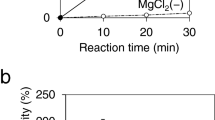Abstract
A soluble glucoside 3-dehydrogenase (G3DH) was purified from a newly isolated Sphingobacterium faecium ZJF-D6 CCTCC M 2013251. The enzyme was purified to 35.71-fold with a yield of 41.91 % and was estimated by sodium dodecyl sulphate–polyacrylamide gel electrophoresis with a molecular mass of 62 kDa. The sequences of two peptides of the enzyme were all contained in a GMC family oxidoreductase (EFK55866) by mass spectrometry analysis. The optimal pH of the enzyme was around 6.2. The enzyme was stable within a pH range of 5.0–6.6 and was sensitive to heat. G3DH from S. faecium exhibited extremely broad substrate specificity and well regioselectivity to validoxylamine A. The enzyme was completely inhibited by Hg2Cl2 and partly inhibited by Cu2+, Fe2+, Ca2+, and Cd2+. The apparent K m values for D-glucose, sucrose, and validoxylamine were calculated to be 1.1, 1.7, and 2.1 mM, respectively. With this purified enzyme, 3-keto sucrose was prepared at pH 5.0, 30 °C for 10 h with a yield of 28.7 %.






Similar content being viewed by others
References
Hayano, K., & Fukui, S. (1967). Purification and properties of 3-ketosucrose-forming enzyme from the cells of Agrobacterium tumefaciens. Journal of Biological Chemistry, 242, 3665–3672.
Maeda, A., Adachi, S., & Matsuno, R. (2001). Improvement of selectivity in 3-ketocellobiose production from cellobiose by Agrobacterium tumefaciens. Biochemical Engineering Journal, 8, 217–221.
Pietsch, M., Walter, M., & Buchholz, K. (1994). Regioselective synthesis of new sucrose derivatives via 3-keto sucrose. Carbohydrate Research, 254, 183–194.
Sode, K., Akaike, E., Sugiura, H., & Tsugawa, W. (2001). Enzymatic synthesis of a novel trehalose derivative, 3,3′-diketoneo-trehalose and its potential application as the trehalase enzyme inhibitor. FEBS Letters, 489, 42–45.
Stoppok, E., Matalla, K., & Buchholz, K. (1992). Microbial modification of sugars as building blocks for chemicals. Applied Microbiology and Biotechnology, 36, 604–610.
Tsugawa, W., Horiuchi, S., Tanaka, M., Wake, H., & Sode, K. (1996). Purification of a marine bacterial glucose dehydrogenase from Cytophaga marinoflava and its Application for measurement of 1,5-anhydro-D-glucitol. Applied Biochemistry and Biotechnology, 56, 301–310.
Hamafuji, T., Tsugawa, W., & Sode, K. (2002). Clinical application of the serum 1,5-anhydroglucitol assay method using glucose 3-dehydrogenase. Journal of Clinical Laboratory Analysis, 6, 299–303.
Tsugawa, W., Ogasawara, N., & Sode, K. (1998). Fluorescent measurement of 1,5-anhydro-D-glucitol based on a novel marine bacterial glucose dehydrogenase. Enzyme and Microbial Technology, 22, 269–274.
Takeuchi, M., Ninomiya, K., Kawabata, K., Asano, N., Kameda, Y., & Matsui, K. (1986). Purification and properties of glucoside 3-dehydrogenase from Flavobacterium saccharophilum. Journal of Biochemistry, 100(4), 1049–1055.
Morrison, S. C., Wood, D. A., & Wood, P. M. (1999). Characterization of a glucose 3-dehydrogenase from the cultivated mushroom (Agaricus bisporus). Applied Microbiology and Biotechnology, 51(1), 58–64.
Kojima, K., Tsugawa, W., Hamahuji, T., Watazu, Y., & Sode, K. (1999). Effect of growth substrates on production of new soluble glucose 3-dehydrogenase in Halomonas (Deleya) sp.-15. Applied Biochemistry and Biotechnology, 77–79, 827–834.
Zhang, J. F., Zheng, Y. G., & Shen, Y. C. (2006). Purification and characterization of the glucoside 3-dehydrogenase produced by a newly isolated Stenotrophomonas maltrophilia CCTCC M 204024. Applied Microbiology and Biotechnology, 71(5), 638–645.
Zheng, Y. G., Jin, L. Q., & Shen, Y. C. (2004). Resin-catalyzed degradation of validamycin A for production of validoxylamine A. Catalysis Communications, 5, 519–525.
Bradford, M. M. (1976). A rapid and sensitive method for the quantitation of microgram quantities of protein utilizing the principle of protein-dye binding. Analytical Biochemistry, 72, 248–254.
Takeuchi, M., Asano, N., Kameda, Y., & Matsui, K. (1988). Purification and properties of soluble D-glucoside 3-dehydrogenase from Flavobacterium saccharophilum. Agricultural and Biological Chemistry, 52(8), 1905–1912.
Pau, C. P., Patonay, G., Moss, C. W., Hollis, D., Carlone, G. M., Plikaytis, B. D., et al. (1987). Comparison of Flavobacterium and Sphingobacterium species by enzyme profiles, with use of pattern recognition of two-dimensional fluorescence data. Clinical Chemistry, 33(3), 377–380.
Albrecht, M., & Lengauer, T. (2003). Pyranose oxidase identified as a member of the GMC oxidoreductase family. Bioinformatics, 19(10), 1216–1220.
Fukui, S., & Hayano, K. (1969). Micro methods for determination of 3-ketosucrose and 3-ketoglucose. Agricultural and Biological Chemistry, 33, 1013–1017.
Xu, H., Yang, J. T., Bai, L. Q., Deng, Z. X., & Mahmud, T. (2009). Genetically engineered production of 1,1′-bis-valienamine and validienamycin in Streptomyces hygroscopicus and their conversion to valienamine. Applied Microbiology and Biotechnology, 81(5), 895–902.
Zhang, J. F., Zheng, Y. G., Liu, Z. Q., & Shen, Y. C. (2007). Preparation of 3-keto validoxylamine A C-N lyase substrate: N-p-nitrophenyl-3-ketovalidamine by Stenotrophomonas maltrophilia CCTCC M 204024. Applied Microbiology and Biotechnology, 73(6), 1275–1281.
Acknowledgements
This work was supported by the National Natural Science Foundation of China (No. 21102131), the Natural Science Foundation of Zhejiang Province (No. Y4100339) and the Introducing compound universities to build Innovative carrier of Zhejiang Province (No. 2012E80002).
Author information
Authors and Affiliations
Corresponding author
Rights and permissions
About this article
Cite this article
Zhang, JF., Yang, B., Chen, W. et al. Purification and Characterization of the Glucoside 3-Dehydrogenase Produced by a Newly Isolated Sphingobacterium faecium ZJF-D6 CCTCC M 2013251. Appl Biochem Biotechnol 172, 3913–3925 (2014). https://doi.org/10.1007/s12010-014-0816-3
Received:
Accepted:
Published:
Issue Date:
DOI: https://doi.org/10.1007/s12010-014-0816-3




